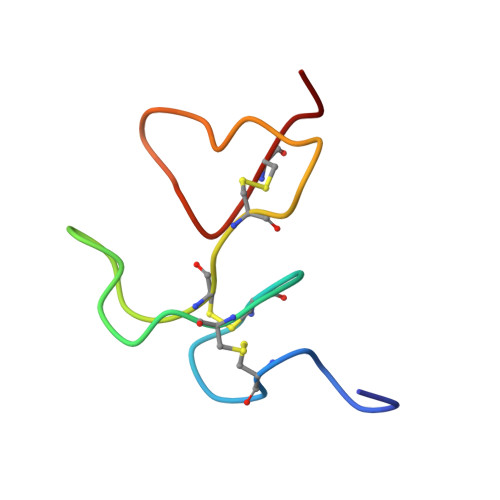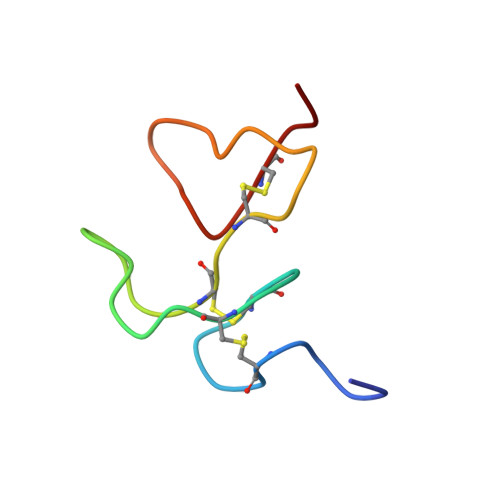Synthesis, Activity, and Preliminary Structure of the Fourth Egf-Like Domain of Thrombomodulin
Meininger, D.P., Hunter, M.J., Komives, E.A.(1995) Protein Sci 4: 1683-1695
- PubMed: 8528067
- DOI: https://doi.org/10.1002/pro.5560040904
- Primary Citation of Related Structures:
1ZAQ - PubMed Abstract:
The fourth EGF-like domain of thrombomodulin (TM4), residues E346-F389 in the TM sequence, has been synthesized. Refolding of the synthetic product under redox conditions gave a single major product. The disulfide bonding pattern of the folded, oxidized domain was (1-3, 2-4, 5-6), which is the same as that found in EGF protein. TM4 was tested for TM anticoagulant activity because deletion and substitution mutagenesis experiments have shown that the fourth EGF-like domain of TM is essential for TM cofactor activity. TM4 showed no TM-like activity in two assay systems, both for inhibition of fibrin clot formation, and for cofactor activity in thrombin activation of protein C. A preliminary structure of TM4 was determined by 2D 1H NMR from 519 NOE-derived distance constraints. Distance geometry calculations yielded a single convergent structure. The structure resembles the structure of EGF and other known EGF-like domains but has some key differences. The central two-stranded beta-sheet is conserved despite the differences in the number of amino acids in the loops. The C-terminal loop formed by the disulfide bond between C372 and C386 in TM4 is five amino acids longer than the analogous loop between C33 and C42 of EGF protein. This loop appears to have a different fold in TM4 than in EGF protein. The loop forms the two outside strands of a broken, irregular tri-stranded beta-sheet, and amino acids H384-F389 lie between the two strands forming the middle strand of the sheet. Thus, although the C-terminus of EGF protein forms one of the outside strands of a tri-stranded antiparallel sheet, the C-terminus of TM4 forms the inside strand of an irregular tri-stranded parallel-anti-parallel sheet. The residues D349, E357, and E374, which were shown to be critical for cofactor activity by alanine scanning mutagenesis, all lie in a patch near the C-terminal loop, and are solvent accessible. The other critical residues, Y358 and F376, are largely buried and appear to play essential structural rather than functional roles.
Organizational Affiliation:
Department of Chemistry and Biochemistry, University of California-San Diego, La Jolla 92093-0601, USA.


















